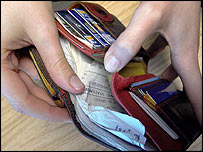
Sub-prime lending comes in many different guises
|
Providing loans and mortgages for people with poor credit histories, so-called sub-prime lending, has been big business in the US and UK over the past few years. But a shadow has been cast over the industry as some lenders have been threatened with bankruptcy.
What is sub-prime lending? Put simply, it is loans to people who have patchy credit histories or cannot prove their incomes. Sub-prime lending, which has become increasingly popular in the US and UK, takes several different forms. In its simplest form, it involves doorstep lending - small amounts of cash loaned to people usually on low incomes and then collected from their own homes. But there are also sub-prime mortgages. This is when people borrow against the increased value of their homes, often to pay off other borrowings. The term can also apply to mortgages taken out by people who are not attractive to mainstream lenders because of their credit history or employment status. So why all the worry? Well, New Century Financial - a major sub-prime lender in the US - has had its shares suspended on the New York Stock Exchange. New Century has been hit by a rise in default rates in the sub-prime sector, meaning fewer of its customers have been able to keep up with mortgage and loan repayments. A slowdown in the US housing market coupled with rising US interest rates have also hit the company. New Century is not alone, though. Sub-prime lender Accredited Home Lenders Holding saw more than 75% wiped off its value in two days after it revealed that it may have to raise extra funds, seek debt waivers, cut jobs and put back its earnings announcement. And UK banking giant HSBC has been struggling with bad-debt provisions in the US since it bought sub-prime lender Household International, which it renamed HSBC Finance. HSBC revealed earlier this month that its bad debt provisions for 2006 would be about $10.5bn (£5bn) - largely because of mortgage defaults. But isn't it risky to lend money to people with a poor credit history? Yes, the risks to the lender are higher than is the case with a mainstream loan. However, the level of bad debts recorded by most sub-prime lenders had, until recently, been relatively low. Traditionally, the big UK retail banks have steered clear of sub-prime lending. But some big names such as HSBC and Alliance & Leicester have been targeting the sub-prime market. Adverts offering loans and mortgages to people with poor credit histories are widespread on cable and satellite TV channels. However, reports last year suggested that Britain's Financial Services Authority (FSA) was becoming worried at the amount of money flooding into the sub-prime market. It suggested that investment banks - which help fund the sub-prime market - could get their fingers burnt if the economy were to suffer a downturn. Do sub-prime lenders charge a premium? Yes, they do. They argue that they have to do this to reflect the greater risk of borrowers defaulting. How big is the sub-prime market? Investment bank Merrill Lynch has estimated that the sub-prime mortgage market in the UK alone was worth between £25bn and £30bn in 2005. According to market analyst group Datamonitor, mainstream mortgage lending grew by 4.1% in the year previous to that, while sub-prime mortgage lending rose 9.1% for the period. Until recently, the future of the sub-prime sector had looked rosy. But the troubles besetting New Century Financial in the US, and higher interest rates in the US, UK and across Europe, have raised concerns in some corners about the long-term viability of the industry.
|
~RS~q~RS~~RS~z~RS~08~RS~)
~RS~q~RS~~RS~z~RS~08~RS~)
Bookmark with:
What are these?